Mental Health Care Case Study Analysis: Jeremy Oaxley's Challenges
VerifiedAdded on 2020/03/28
|7
|2520
|528
Case Study
AI Summary
This case study analyzes the challenging mental health journey of Jeremy Oaxley, a talented singer and songwriter grappling with schizophrenia, alcoholism, and the complexities of his personal and professional life. The analysis delves into the various factors influencing his condition, including cultural, social, and developmental aspects, highlighting the impact of stigma and societal misunderstandings on access to care. The study examines the application of the national mental health framework, particularly the recovery-oriented approach, emphasizing the importance of patient-centered care, promoting hope, and upholding patient rights. It also explores the role of family engagement and the need for tailored interventions to improve patient outcomes, including the need for the family to be engaged in therapeutic encounters for the patients and their families. The study underscores the significance of incorporating the framework in managing mental health conditions, especially in home settings, and its role in influencing the design of services, such as trauma-informed approaches, to effectively manage Jeremy's condition, aligning with the Australian National Standards for Mental Health Services.
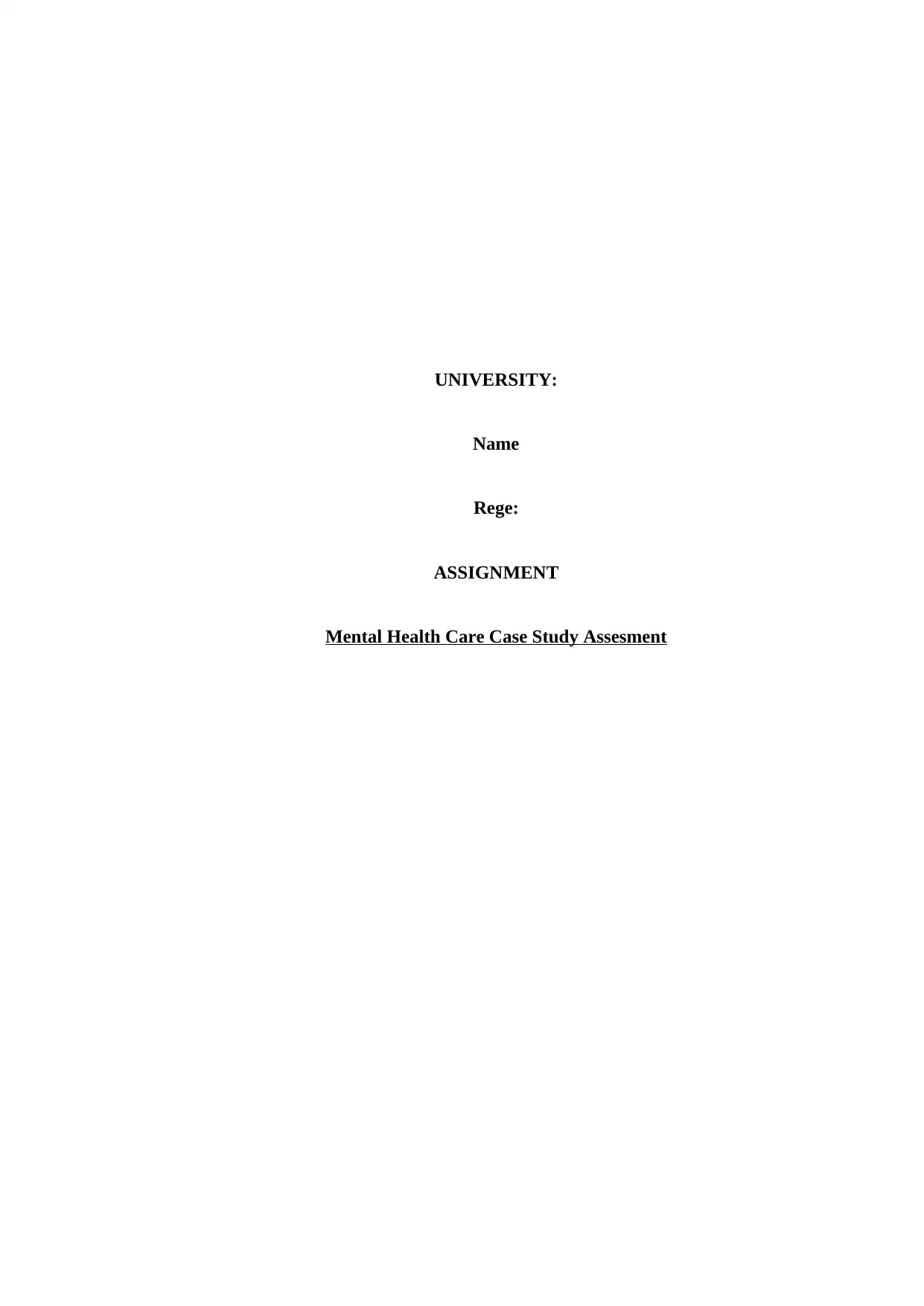
UNIVERSITY:
Name
Rege:
ASSIGNMENT
Mental Health Care Case Study Assesment
Name
Rege:
ASSIGNMENT
Mental Health Care Case Study Assesment
Paraphrase This Document
Need a fresh take? Get an instant paraphrase of this document with our AI Paraphraser
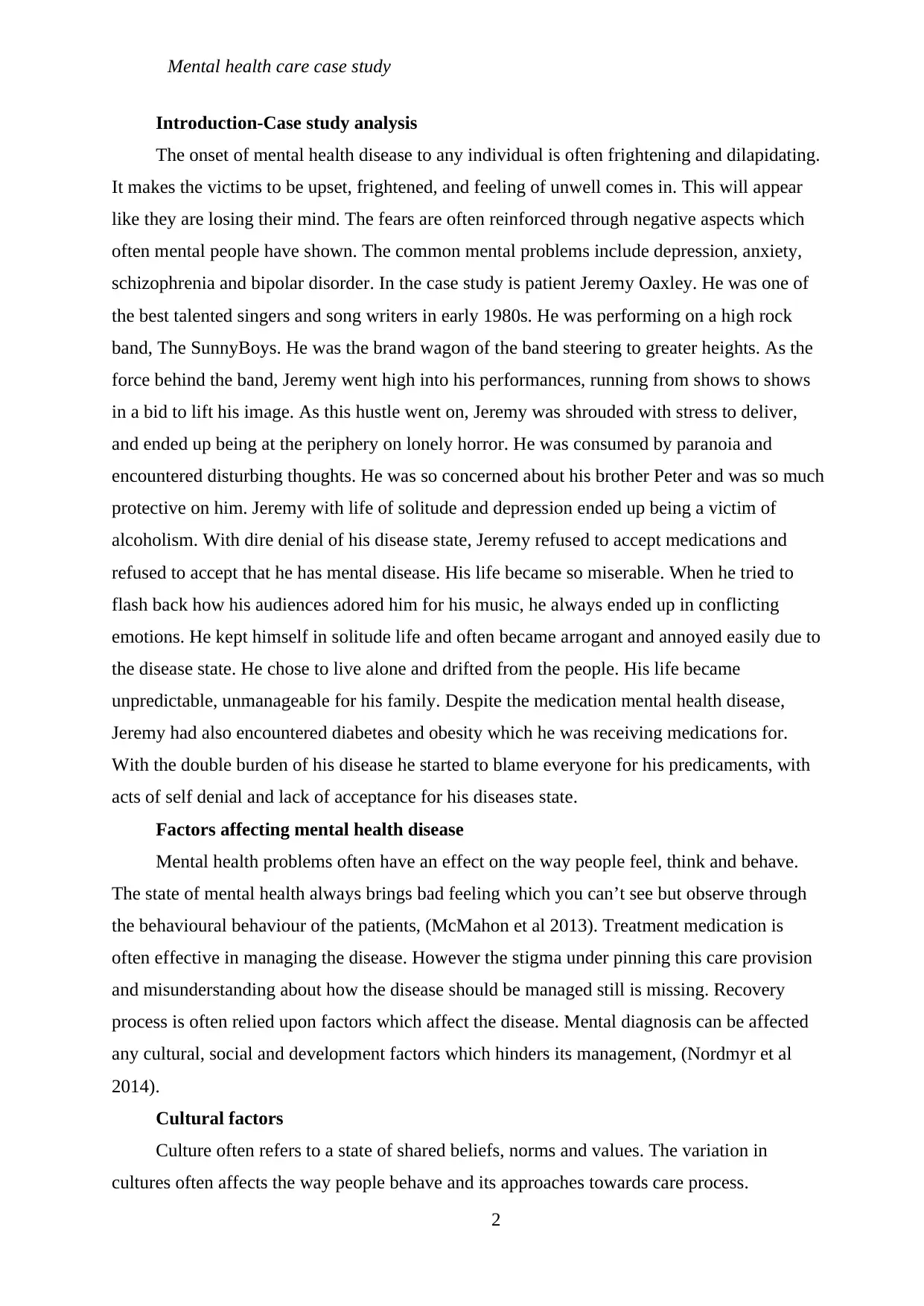
Mental health care case study
Introduction-Case study analysis
The onset of mental health disease to any individual is often frightening and dilapidating.
It makes the victims to be upset, frightened, and feeling of unwell comes in. This will appear
like they are losing their mind. The fears are often reinforced through negative aspects which
often mental people have shown. The common mental problems include depression, anxiety,
schizophrenia and bipolar disorder. In the case study is patient Jeremy Oaxley. He was one of
the best talented singers and song writers in early 1980s. He was performing on a high rock
band, The SunnyBoys. He was the brand wagon of the band steering to greater heights. As the
force behind the band, Jeremy went high into his performances, running from shows to shows
in a bid to lift his image. As this hustle went on, Jeremy was shrouded with stress to deliver,
and ended up being at the periphery on lonely horror. He was consumed by paranoia and
encountered disturbing thoughts. He was so concerned about his brother Peter and was so much
protective on him. Jeremy with life of solitude and depression ended up being a victim of
alcoholism. With dire denial of his disease state, Jeremy refused to accept medications and
refused to accept that he has mental disease. His life became so miserable. When he tried to
flash back how his audiences adored him for his music, he always ended up in conflicting
emotions. He kept himself in solitude life and often became arrogant and annoyed easily due to
the disease state. He chose to live alone and drifted from the people. His life became
unpredictable, unmanageable for his family. Despite the medication mental health disease,
Jeremy had also encountered diabetes and obesity which he was receiving medications for.
With the double burden of his disease he started to blame everyone for his predicaments, with
acts of self denial and lack of acceptance for his diseases state.
Factors affecting mental health disease
Mental health problems often have an effect on the way people feel, think and behave.
The state of mental health always brings bad feeling which you can’t see but observe through
the behavioural behaviour of the patients, (McMahon et al 2013). Treatment medication is
often effective in managing the disease. However the stigma under pinning this care provision
and misunderstanding about how the disease should be managed still is missing. Recovery
process is often relied upon factors which affect the disease. Mental diagnosis can be affected
any cultural, social and development factors which hinders its management, (Nordmyr et al
2014).
Cultural factors
Culture often refers to a state of shared beliefs, norms and values. The variation in
cultures often affects the way people behave and its approaches towards care process.
2
Introduction-Case study analysis
The onset of mental health disease to any individual is often frightening and dilapidating.
It makes the victims to be upset, frightened, and feeling of unwell comes in. This will appear
like they are losing their mind. The fears are often reinforced through negative aspects which
often mental people have shown. The common mental problems include depression, anxiety,
schizophrenia and bipolar disorder. In the case study is patient Jeremy Oaxley. He was one of
the best talented singers and song writers in early 1980s. He was performing on a high rock
band, The SunnyBoys. He was the brand wagon of the band steering to greater heights. As the
force behind the band, Jeremy went high into his performances, running from shows to shows
in a bid to lift his image. As this hustle went on, Jeremy was shrouded with stress to deliver,
and ended up being at the periphery on lonely horror. He was consumed by paranoia and
encountered disturbing thoughts. He was so concerned about his brother Peter and was so much
protective on him. Jeremy with life of solitude and depression ended up being a victim of
alcoholism. With dire denial of his disease state, Jeremy refused to accept medications and
refused to accept that he has mental disease. His life became so miserable. When he tried to
flash back how his audiences adored him for his music, he always ended up in conflicting
emotions. He kept himself in solitude life and often became arrogant and annoyed easily due to
the disease state. He chose to live alone and drifted from the people. His life became
unpredictable, unmanageable for his family. Despite the medication mental health disease,
Jeremy had also encountered diabetes and obesity which he was receiving medications for.
With the double burden of his disease he started to blame everyone for his predicaments, with
acts of self denial and lack of acceptance for his diseases state.
Factors affecting mental health disease
Mental health problems often have an effect on the way people feel, think and behave.
The state of mental health always brings bad feeling which you can’t see but observe through
the behavioural behaviour of the patients, (McMahon et al 2013). Treatment medication is
often effective in managing the disease. However the stigma under pinning this care provision
and misunderstanding about how the disease should be managed still is missing. Recovery
process is often relied upon factors which affect the disease. Mental diagnosis can be affected
any cultural, social and development factors which hinders its management, (Nordmyr et al
2014).
Cultural factors
Culture often refers to a state of shared beliefs, norms and values. The variation in
cultures often affects the way people behave and its approaches towards care process.
2

Mental health care case study
Depending on the culture one grew up, feelings of emotional health can always affect the way
patients are managed, and how the experience s are given the best coping measures for the
care. in many cultures around the world, mental health has often been associated with spiritual
life’s of the patients, thus how a person perceive mental health experience have an effect on the
personal felling you have, (WHO, 2014). Cultural influences and societal influences have an
effect on mental health care approach. Culture and social contextual nature often shapes the
mental health of minorities and available mental health priorities available. The
misunderstandings often found in culture among the care providers often deters access of
health services and access and utilization of care and preventing them from adequate care
provision, (Bjereld et al 2015). Patient culture often known as consumer mental health services
has an effect on mental health care and utilization access. In this case study, patient Jeremy
might not have been exposed to the culture of seeking medical intervention thus the restrictive
nature and solitude denial he is facing.
Social aspects of mental health
Many dimensions of mental health and psychological well being are determined by the
social factors which include, gender, social status, race and ethnical backgrounds. The ability
of coping effectively with patients of mental health have often depend on the social
arrangements which take place within the family or community set ups. In this case Jeremy
social state is affected at how the family is treating him and according him the care needed.
Mental illness epidemiology is complicated but how the relationship between symptoms
occurrence, drug use and illness vary with the families support networks, (Funk,2016). The
stigma often associated with mental health disease has led to perception of the disease, the
cumulative burdens the disease cause on the family and those sorrowing the care are huge,
(Bjereld et al 2015). These burdens depend on the magnitude of schizophrenia for patient
Jeremy.
Developmental factors affecting mental health
Assessments of positive aspects of development and is aligned competencies are viewed
as the scientific underpinnings which inform promotion of mental health disease. Prevention
and promotion model for the young people entails interventions which alters the developmental
process. This is essential in ensuring that the filed be grounded on a comprehensive framework
that has a reflection on the developmental perspective. the most important feature so
development process that are key to the case study include, age related patters of schizophrenia
disorder for the patient, tasks involved and interactions between the biological and
psychological and social aspects with regard to the patent status, (Conley et al 2017).
3
Depending on the culture one grew up, feelings of emotional health can always affect the way
patients are managed, and how the experience s are given the best coping measures for the
care. in many cultures around the world, mental health has often been associated with spiritual
life’s of the patients, thus how a person perceive mental health experience have an effect on the
personal felling you have, (WHO, 2014). Cultural influences and societal influences have an
effect on mental health care approach. Culture and social contextual nature often shapes the
mental health of minorities and available mental health priorities available. The
misunderstandings often found in culture among the care providers often deters access of
health services and access and utilization of care and preventing them from adequate care
provision, (Bjereld et al 2015). Patient culture often known as consumer mental health services
has an effect on mental health care and utilization access. In this case study, patient Jeremy
might not have been exposed to the culture of seeking medical intervention thus the restrictive
nature and solitude denial he is facing.
Social aspects of mental health
Many dimensions of mental health and psychological well being are determined by the
social factors which include, gender, social status, race and ethnical backgrounds. The ability
of coping effectively with patients of mental health have often depend on the social
arrangements which take place within the family or community set ups. In this case Jeremy
social state is affected at how the family is treating him and according him the care needed.
Mental illness epidemiology is complicated but how the relationship between symptoms
occurrence, drug use and illness vary with the families support networks, (Funk,2016). The
stigma often associated with mental health disease has led to perception of the disease, the
cumulative burdens the disease cause on the family and those sorrowing the care are huge,
(Bjereld et al 2015). These burdens depend on the magnitude of schizophrenia for patient
Jeremy.
Developmental factors affecting mental health
Assessments of positive aspects of development and is aligned competencies are viewed
as the scientific underpinnings which inform promotion of mental health disease. Prevention
and promotion model for the young people entails interventions which alters the developmental
process. This is essential in ensuring that the filed be grounded on a comprehensive framework
that has a reflection on the developmental perspective. the most important feature so
development process that are key to the case study include, age related patters of schizophrenia
disorder for the patient, tasks involved and interactions between the biological and
psychological and social aspects with regard to the patent status, (Conley et al 2017).
3
⊘ This is a preview!⊘
Do you want full access?
Subscribe today to unlock all pages.

Trusted by 1+ million students worldwide
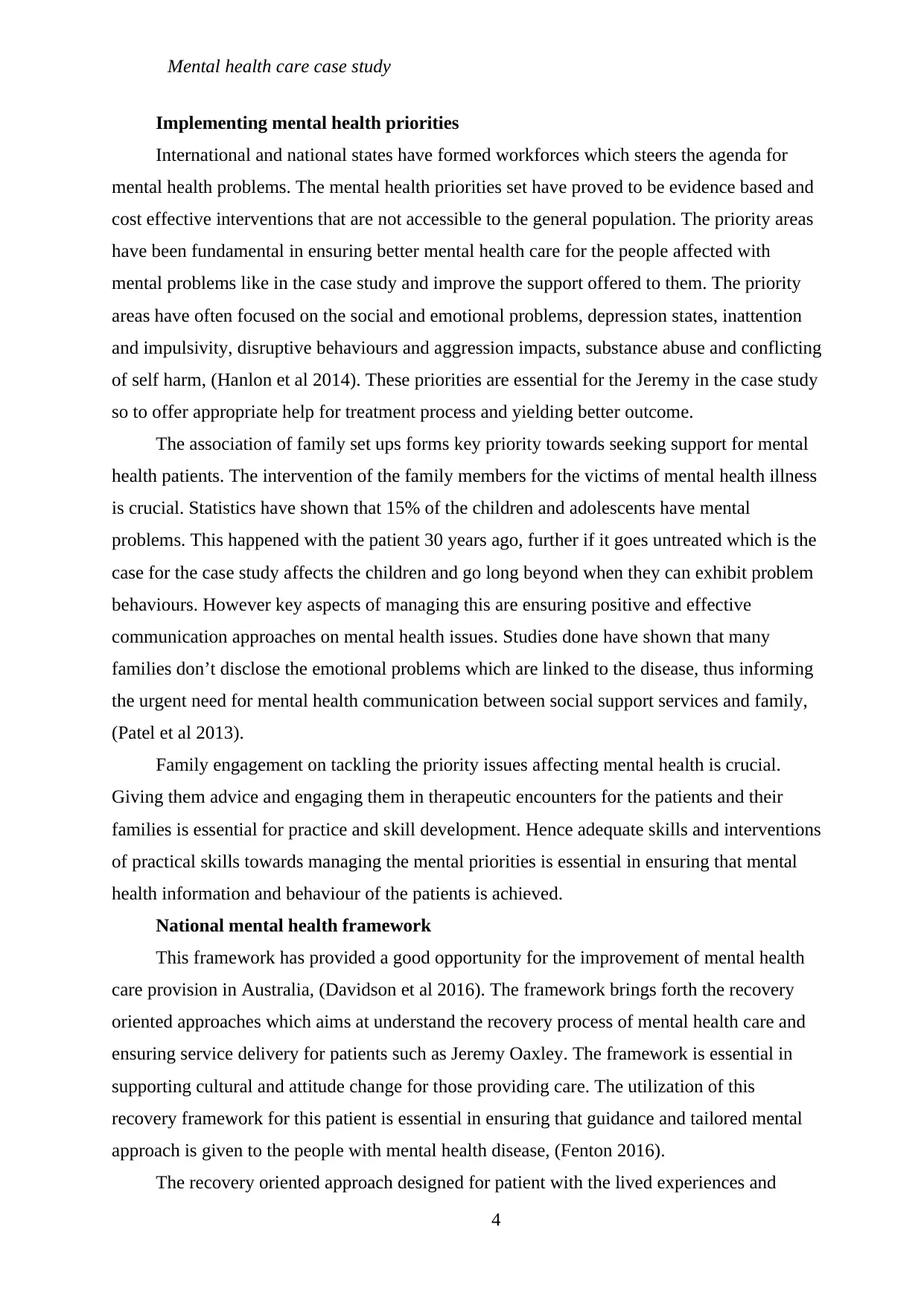
Mental health care case study
Implementing mental health priorities
International and national states have formed workforces which steers the agenda for
mental health problems. The mental health priorities set have proved to be evidence based and
cost effective interventions that are not accessible to the general population. The priority areas
have been fundamental in ensuring better mental health care for the people affected with
mental problems like in the case study and improve the support offered to them. The priority
areas have often focused on the social and emotional problems, depression states, inattention
and impulsivity, disruptive behaviours and aggression impacts, substance abuse and conflicting
of self harm, (Hanlon et al 2014). These priorities are essential for the Jeremy in the case study
so to offer appropriate help for treatment process and yielding better outcome.
The association of family set ups forms key priority towards seeking support for mental
health patients. The intervention of the family members for the victims of mental health illness
is crucial. Statistics have shown that 15% of the children and adolescents have mental
problems. This happened with the patient 30 years ago, further if it goes untreated which is the
case for the case study affects the children and go long beyond when they can exhibit problem
behaviours. However key aspects of managing this are ensuring positive and effective
communication approaches on mental health issues. Studies done have shown that many
families don’t disclose the emotional problems which are linked to the disease, thus informing
the urgent need for mental health communication between social support services and family,
(Patel et al 2013).
Family engagement on tackling the priority issues affecting mental health is crucial.
Giving them advice and engaging them in therapeutic encounters for the patients and their
families is essential for practice and skill development. Hence adequate skills and interventions
of practical skills towards managing the mental priorities is essential in ensuring that mental
health information and behaviour of the patients is achieved.
National mental health framework
This framework has provided a good opportunity for the improvement of mental health
care provision in Australia, (Davidson et al 2016). The framework brings forth the recovery
oriented approaches which aims at understand the recovery process of mental health care and
ensuring service delivery for patients such as Jeremy Oaxley. The framework is essential in
supporting cultural and attitude change for those providing care. The utilization of this
recovery framework for this patient is essential in ensuring that guidance and tailored mental
approach is given to the people with mental health disease, (Fenton 2016).
The recovery oriented approach designed for patient with the lived experiences and
4
Implementing mental health priorities
International and national states have formed workforces which steers the agenda for
mental health problems. The mental health priorities set have proved to be evidence based and
cost effective interventions that are not accessible to the general population. The priority areas
have been fundamental in ensuring better mental health care for the people affected with
mental problems like in the case study and improve the support offered to them. The priority
areas have often focused on the social and emotional problems, depression states, inattention
and impulsivity, disruptive behaviours and aggression impacts, substance abuse and conflicting
of self harm, (Hanlon et al 2014). These priorities are essential for the Jeremy in the case study
so to offer appropriate help for treatment process and yielding better outcome.
The association of family set ups forms key priority towards seeking support for mental
health patients. The intervention of the family members for the victims of mental health illness
is crucial. Statistics have shown that 15% of the children and adolescents have mental
problems. This happened with the patient 30 years ago, further if it goes untreated which is the
case for the case study affects the children and go long beyond when they can exhibit problem
behaviours. However key aspects of managing this are ensuring positive and effective
communication approaches on mental health issues. Studies done have shown that many
families don’t disclose the emotional problems which are linked to the disease, thus informing
the urgent need for mental health communication between social support services and family,
(Patel et al 2013).
Family engagement on tackling the priority issues affecting mental health is crucial.
Giving them advice and engaging them in therapeutic encounters for the patients and their
families is essential for practice and skill development. Hence adequate skills and interventions
of practical skills towards managing the mental priorities is essential in ensuring that mental
health information and behaviour of the patients is achieved.
National mental health framework
This framework has provided a good opportunity for the improvement of mental health
care provision in Australia, (Davidson et al 2016). The framework brings forth the recovery
oriented approaches which aims at understand the recovery process of mental health care and
ensuring service delivery for patients such as Jeremy Oaxley. The framework is essential in
supporting cultural and attitude change for those providing care. The utilization of this
recovery framework for this patient is essential in ensuring that guidance and tailored mental
approach is given to the people with mental health disease, (Fenton 2016).
The recovery oriented approach designed for patient with the lived experiences and
4
Paraphrase This Document
Need a fresh take? Get an instant paraphrase of this document with our AI Paraphraser
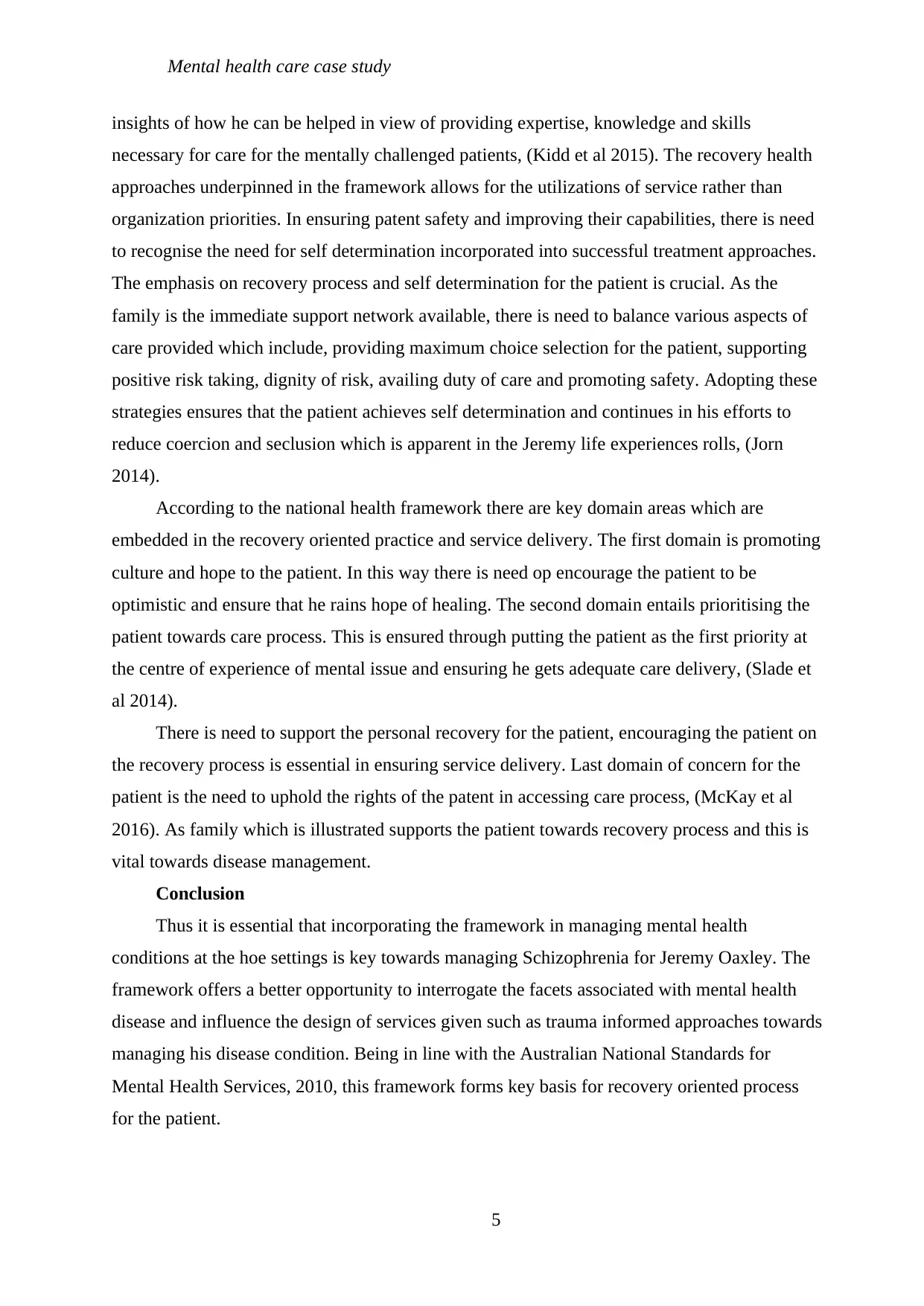
Mental health care case study
insights of how he can be helped in view of providing expertise, knowledge and skills
necessary for care for the mentally challenged patients, (Kidd et al 2015). The recovery health
approaches underpinned in the framework allows for the utilizations of service rather than
organization priorities. In ensuring patent safety and improving their capabilities, there is need
to recognise the need for self determination incorporated into successful treatment approaches.
The emphasis on recovery process and self determination for the patient is crucial. As the
family is the immediate support network available, there is need to balance various aspects of
care provided which include, providing maximum choice selection for the patient, supporting
positive risk taking, dignity of risk, availing duty of care and promoting safety. Adopting these
strategies ensures that the patient achieves self determination and continues in his efforts to
reduce coercion and seclusion which is apparent in the Jeremy life experiences rolls, (Jorn
2014).
According to the national health framework there are key domain areas which are
embedded in the recovery oriented practice and service delivery. The first domain is promoting
culture and hope to the patient. In this way there is need op encourage the patient to be
optimistic and ensure that he rains hope of healing. The second domain entails prioritising the
patient towards care process. This is ensured through putting the patient as the first priority at
the centre of experience of mental issue and ensuring he gets adequate care delivery, (Slade et
al 2014).
There is need to support the personal recovery for the patient, encouraging the patient on
the recovery process is essential in ensuring service delivery. Last domain of concern for the
patient is the need to uphold the rights of the patent in accessing care process, (McKay et al
2016). As family which is illustrated supports the patient towards recovery process and this is
vital towards disease management.
Conclusion
Thus it is essential that incorporating the framework in managing mental health
conditions at the hoe settings is key towards managing Schizophrenia for Jeremy Oaxley. The
framework offers a better opportunity to interrogate the facets associated with mental health
disease and influence the design of services given such as trauma informed approaches towards
managing his disease condition. Being in line with the Australian National Standards for
Mental Health Services, 2010, this framework forms key basis for recovery oriented process
for the patient.
5
insights of how he can be helped in view of providing expertise, knowledge and skills
necessary for care for the mentally challenged patients, (Kidd et al 2015). The recovery health
approaches underpinned in the framework allows for the utilizations of service rather than
organization priorities. In ensuring patent safety and improving their capabilities, there is need
to recognise the need for self determination incorporated into successful treatment approaches.
The emphasis on recovery process and self determination for the patient is crucial. As the
family is the immediate support network available, there is need to balance various aspects of
care provided which include, providing maximum choice selection for the patient, supporting
positive risk taking, dignity of risk, availing duty of care and promoting safety. Adopting these
strategies ensures that the patient achieves self determination and continues in his efforts to
reduce coercion and seclusion which is apparent in the Jeremy life experiences rolls, (Jorn
2014).
According to the national health framework there are key domain areas which are
embedded in the recovery oriented practice and service delivery. The first domain is promoting
culture and hope to the patient. In this way there is need op encourage the patient to be
optimistic and ensure that he rains hope of healing. The second domain entails prioritising the
patient towards care process. This is ensured through putting the patient as the first priority at
the centre of experience of mental issue and ensuring he gets adequate care delivery, (Slade et
al 2014).
There is need to support the personal recovery for the patient, encouraging the patient on
the recovery process is essential in ensuring service delivery. Last domain of concern for the
patient is the need to uphold the rights of the patent in accessing care process, (McKay et al
2016). As family which is illustrated supports the patient towards recovery process and this is
vital towards disease management.
Conclusion
Thus it is essential that incorporating the framework in managing mental health
conditions at the hoe settings is key towards managing Schizophrenia for Jeremy Oaxley. The
framework offers a better opportunity to interrogate the facets associated with mental health
disease and influence the design of services given such as trauma informed approaches towards
managing his disease condition. Being in line with the Australian National Standards for
Mental Health Services, 2010, this framework forms key basis for recovery oriented process
for the patient.
5
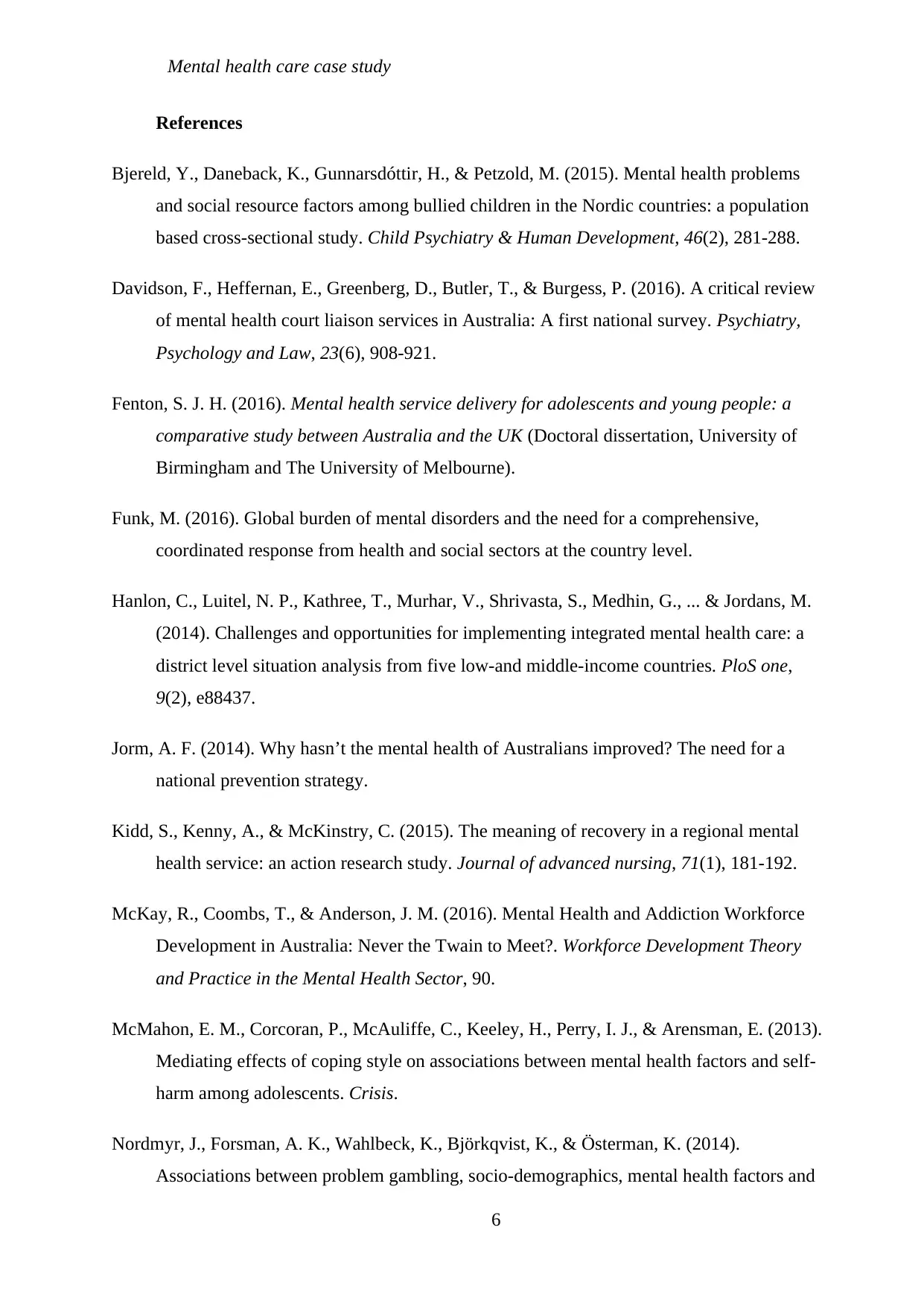
Mental health care case study
References
Bjereld, Y., Daneback, K., Gunnarsdóttir, H., & Petzold, M. (2015). Mental health problems
and social resource factors among bullied children in the Nordic countries: a population
based cross-sectional study. Child Psychiatry & Human Development, 46(2), 281-288.
Davidson, F., Heffernan, E., Greenberg, D., Butler, T., & Burgess, P. (2016). A critical review
of mental health court liaison services in Australia: A first national survey. Psychiatry,
Psychology and Law, 23(6), 908-921.
Fenton, S. J. H. (2016). Mental health service delivery for adolescents and young people: a
comparative study between Australia and the UK (Doctoral dissertation, University of
Birmingham and The University of Melbourne).
Funk, M. (2016). Global burden of mental disorders and the need for a comprehensive,
coordinated response from health and social sectors at the country level.
Hanlon, C., Luitel, N. P., Kathree, T., Murhar, V., Shrivasta, S., Medhin, G., ... & Jordans, M.
(2014). Challenges and opportunities for implementing integrated mental health care: a
district level situation analysis from five low-and middle-income countries. PloS one,
9(2), e88437.
Jorm, A. F. (2014). Why hasn’t the mental health of Australians improved? The need for a
national prevention strategy.
Kidd, S., Kenny, A., & McKinstry, C. (2015). The meaning of recovery in a regional mental
health service: an action research study. Journal of advanced nursing, 71(1), 181-192.
McKay, R., Coombs, T., & Anderson, J. M. (2016). Mental Health and Addiction Workforce
Development in Australia: Never the Twain to Meet?. Workforce Development Theory
and Practice in the Mental Health Sector, 90.
McMahon, E. M., Corcoran, P., McAuliffe, C., Keeley, H., Perry, I. J., & Arensman, E. (2013).
Mediating effects of coping style on associations between mental health factors and self-
harm among adolescents. Crisis.
Nordmyr, J., Forsman, A. K., Wahlbeck, K., Björkqvist, K., & Österman, K. (2014).
Associations between problem gambling, socio-demographics, mental health factors and
6
References
Bjereld, Y., Daneback, K., Gunnarsdóttir, H., & Petzold, M. (2015). Mental health problems
and social resource factors among bullied children in the Nordic countries: a population
based cross-sectional study. Child Psychiatry & Human Development, 46(2), 281-288.
Davidson, F., Heffernan, E., Greenberg, D., Butler, T., & Burgess, P. (2016). A critical review
of mental health court liaison services in Australia: A first national survey. Psychiatry,
Psychology and Law, 23(6), 908-921.
Fenton, S. J. H. (2016). Mental health service delivery for adolescents and young people: a
comparative study between Australia and the UK (Doctoral dissertation, University of
Birmingham and The University of Melbourne).
Funk, M. (2016). Global burden of mental disorders and the need for a comprehensive,
coordinated response from health and social sectors at the country level.
Hanlon, C., Luitel, N. P., Kathree, T., Murhar, V., Shrivasta, S., Medhin, G., ... & Jordans, M.
(2014). Challenges and opportunities for implementing integrated mental health care: a
district level situation analysis from five low-and middle-income countries. PloS one,
9(2), e88437.
Jorm, A. F. (2014). Why hasn’t the mental health of Australians improved? The need for a
national prevention strategy.
Kidd, S., Kenny, A., & McKinstry, C. (2015). The meaning of recovery in a regional mental
health service: an action research study. Journal of advanced nursing, 71(1), 181-192.
McKay, R., Coombs, T., & Anderson, J. M. (2016). Mental Health and Addiction Workforce
Development in Australia: Never the Twain to Meet?. Workforce Development Theory
and Practice in the Mental Health Sector, 90.
McMahon, E. M., Corcoran, P., McAuliffe, C., Keeley, H., Perry, I. J., & Arensman, E. (2013).
Mediating effects of coping style on associations between mental health factors and self-
harm among adolescents. Crisis.
Nordmyr, J., Forsman, A. K., Wahlbeck, K., Björkqvist, K., & Österman, K. (2014).
Associations between problem gambling, socio-demographics, mental health factors and
6
⊘ This is a preview!⊘
Do you want full access?
Subscribe today to unlock all pages.

Trusted by 1+ million students worldwide
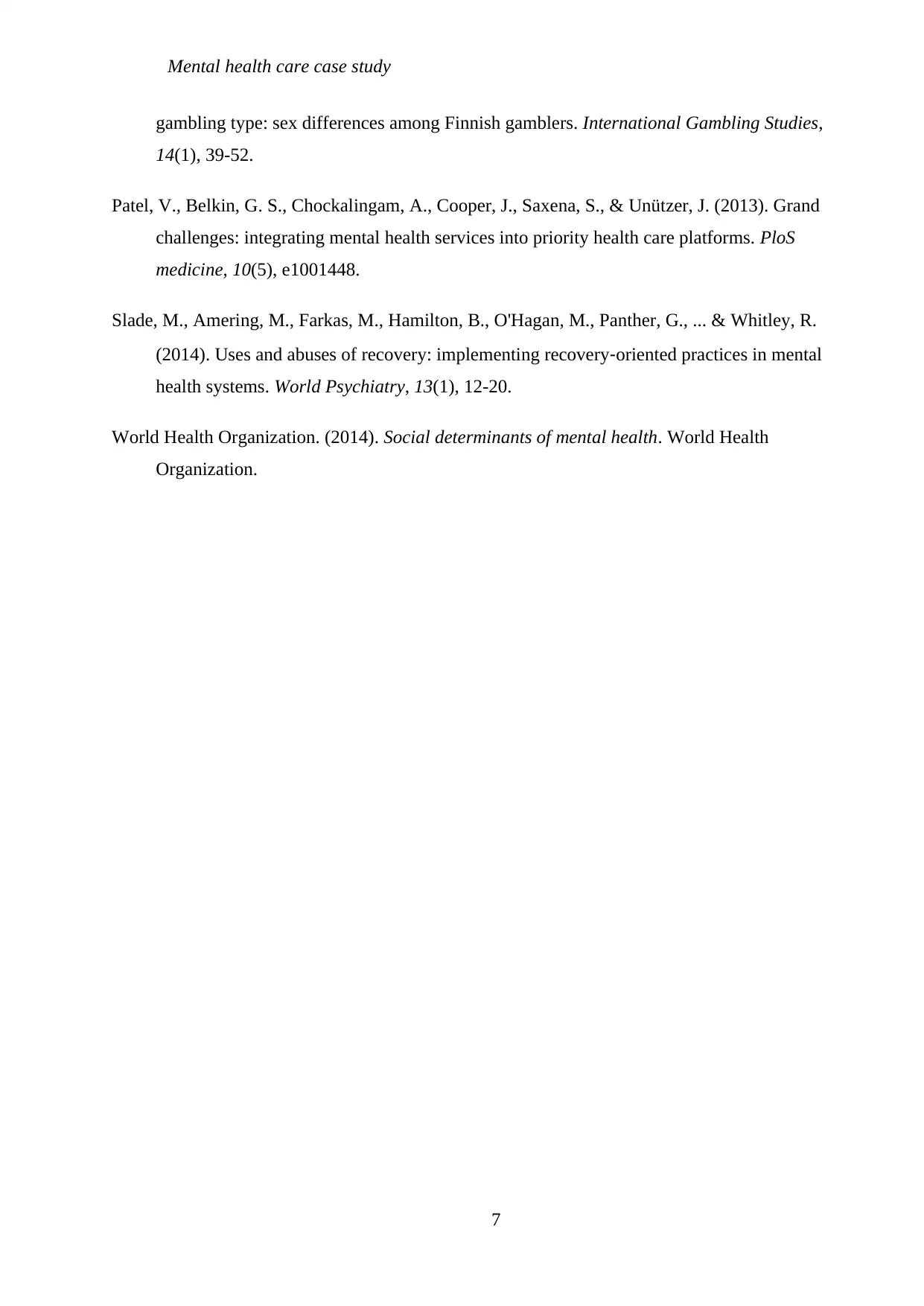
Mental health care case study
gambling type: sex differences among Finnish gamblers. International Gambling Studies,
14(1), 39-52.
Patel, V., Belkin, G. S., Chockalingam, A., Cooper, J., Saxena, S., & Unützer, J. (2013). Grand
challenges: integrating mental health services into priority health care platforms. PloS
medicine, 10(5), e1001448.
Slade, M., Amering, M., Farkas, M., Hamilton, B., O'Hagan, M., Panther, G., ... & Whitley, R.
(2014). Uses and abuses of recovery: implementing recovery‐oriented practices in mental
health systems. World Psychiatry, 13(1), 12-20.
World Health Organization. (2014). Social determinants of mental health. World Health
Organization.
7
gambling type: sex differences among Finnish gamblers. International Gambling Studies,
14(1), 39-52.
Patel, V., Belkin, G. S., Chockalingam, A., Cooper, J., Saxena, S., & Unützer, J. (2013). Grand
challenges: integrating mental health services into priority health care platforms. PloS
medicine, 10(5), e1001448.
Slade, M., Amering, M., Farkas, M., Hamilton, B., O'Hagan, M., Panther, G., ... & Whitley, R.
(2014). Uses and abuses of recovery: implementing recovery‐oriented practices in mental
health systems. World Psychiatry, 13(1), 12-20.
World Health Organization. (2014). Social determinants of mental health. World Health
Organization.
7
1 out of 7
Related Documents
Your All-in-One AI-Powered Toolkit for Academic Success.
+13062052269
info@desklib.com
Available 24*7 on WhatsApp / Email
![[object Object]](/_next/static/media/star-bottom.7253800d.svg)
Unlock your academic potential
Copyright © 2020–2025 A2Z Services. All Rights Reserved. Developed and managed by ZUCOL.





